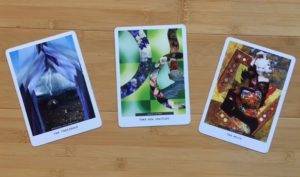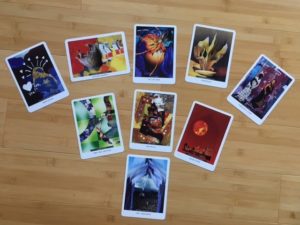 Three Card Draw
Three Card Draw
For a long time I simply used a three-card draw. This keeps the reading simple, but powerful, as sometimes too much information allows the mind to drift away on detail and miss the core messages. It’s helpful to decide ahead of time if you want the position of the cards to represent: Past, Present Future, or Physical, Emotional, Energetic or whatever other three divisions may work for you.
 Nine Card Draw
Nine Card Draw
In the Fall of 2014, I had a dream that introduced a particular lay-out format, and I’ve found it to be helpful and interesting. Here is a photo of a reading I did using this format. You can read about it in my First Blog entry, if you’re interested. It was a powerful one. But, basically, it’s a 1, 3, 5 draw.
The first card is the focal point. I place this card at the bottom and build upwards. The focal card shows a choice to be made, or what is being called for at this time. Then, I generally interpret the next three cards as showing the first wave of response to the focal card. And then the top five as highlighting the further iteration of the motion as intent meets physical reality in time and space.
There are lots of interesting formats to explore. At this time, these are the only two I use, so I’m not comfortable making more suggestions that I haven’t done myself. But, feel free to experiment, if you’re inclined. If I hear from Traveler Oracle users of successes and stories of interest in this regard, I’ll include them in my Blog. And, may offer more over time here in this section.
Group Circle Process
The Traveler Oracle is a marvelous tool to use within a group process. I would recommend, that, depending upon the nature of the group, an agreement be made about confidentiality, so that what’s shared in the group setting stays in the group. This develops trust and is an important aspect of any group therapy process. But, even beyond the therapeutic setting, this can be used with friends, family, or in some other social group context. In the words of a friend of mine who’s used it with groups in a few different contexts, “It has always opened vulnerability and deepened the bonds of friendship.” I would recommend a group of no more than 12.
Sit in a circle, and either put the deck in the center, or just pass it casually to each other when the next person indicates they’re ready to draw (it’s probably best to do this “popcorn” style, to ensure that the next person to draw really is ready to do so).
Have the text read out loud to them by another participant. The person who drew can then take a few moments to process aloud or share any response they have about it, if they’d like to. The value of group process is in the additional comments and insights that may come from others in the circle. Guidelines should be established at the outset as to the nature and process of those additional comments. Perhaps the one who’s turn it is can choose from those who indicate by a hand that have something to say; or perhaps this is a group that’s relaxed enough with each other that it can be less organized than that.
It’s helpful, with groups, to have at least a few guidelines such as treating each other respectfully, and not to use this as a soapbox for your opinions and long personal stories, but share the time with everyone there mindfully.
